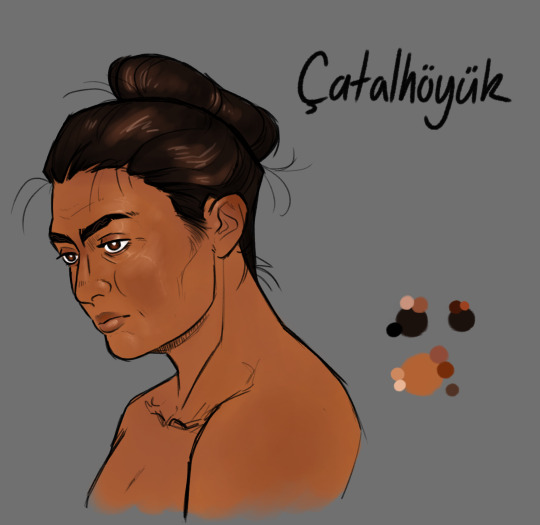#aph catalhoyuk
Explore tagged Tumblr posts
Text

this has been in my head for a few days and i am scared to post but bringing y'all this like a cat with a dead bird
#alpha romeo tango#hetalia#aph ancients#hws ancients#aph catalhoyuk#hws catalhoyuk#don't ask why i wanted to make this it just seemed like a really interesting concept
160 notes
·
View notes
Note
Could we know about catalhoyuk and their relationship with other nations 👀
Ah, that can be hard to say. For Çatalhöyük I am going off of archaeological evidence (namely excavations and studies of murals and artifacts from the site itself). I would argue it's even dubious for me to consider Çatalhöyük as a personification given we have no way to know if they had such a solidified identity. It's not considered urban nor was it a larger city-state that encapsulated further-flung agricultural villages/borderlands spaces into a politically influential region (though proto-city and proto-urban community are two terms generally accepted to use in reference to it in most literature I've consumed). We aren't sure if they would've had an established political body, though I would imagine with 3,000-8,000 clustered together, the people of Çatalhöyük would've had some sort of order in place.
This is a long-winded and rather roundabout way to say that the settlement of Çatalhöyük had no neighbors of similar size or capacity (as far as we know). Any 'neighbors' they may have had were most likely significantly smaller hunter-gather bands - which are typically made up of one to a few family groups, numbering in the tens, not thousands - or were smaller settlements whose legacies didn't preserve in the climate of south-central Turkey. Çatalhöyük as a personification may have been uniquely alone, whether through the fact that she is/they are the "first city" and had no one to compare to, or that any contemporaries they would've had might have come and gone long before they ceased to live. It's good to note that Çatalhöyük would've lived for approximately 1,000 years. (Estimates of continuous settlement of the site range from 1,100-1,500 years.)
Overall though, Çatalhöyük (personification) would've been living like her/their people. In oak-timber proto-row houses without doors, climbing via ladders to rooftops and to other homes. We theorize most things would've been done up on these rooftops; trade, conversation, fabrication of clothes and baskets and necessities, etc. as an early form of market since the site has no "public buildings" and no streets or walkways. We know that the people of this early society participated in early agriculture, farming wheat, barley, peas, lentils, and other legumes. They would've herded goats or sheep, as domestication and agriculture have gone hand-in-hand, which they would've used for food and for their hides as clothing. They also likely made clothing from woven bast fibers - textiles made from the inner bark of trees like willow, oak, and linden!
What we know about religion at Çatalhöyük is also vague. There was no known writing system and our information has mostly come from potentially ritual figurines and murals found throughout parts of both mounds of the site. But I personally would imagine that seeing this person who does not age - at least not like she should compared to everyone else - and seeing that she can perform feats that normal men cannot might make her seem like much of a divine figure. I know it's rather common fanon that the Ancients in Hetalia (or modern Nations who have also been around long enough to be considered so) would've been revered like gods. That, I think, would be interesting to play with. (A personal side note, I like to think that personifications of the later cities Eridu, Uruk, and Ur were female and therefore seen as emissaries of/faces of the goddess Ishtar (or Inanna).)
As for Çatalhöyük's relationship with other Nations, who at this time would've simply been cities or city-states, not nations as we see them today, I think their relationship is murky at best. No modern National personification we have today would have met Çatalhöyük. They know about them from archaeology, from literature, or from stories passed poorly down more in the cadence of a legend than factual anecdote. They are The First if not merely one of the firsts of their kind, which makes them special, but with that comes packaged the unfortunate tragedy that so much of Çatalhöyük's everything has been lost to time, to modern factors, and to the Earth itself.
However, this is something I'd love to do more research on so I could theorize better.
#callsign gremlin checking in#mooom! gremlin’s archaeologyposting again!#çatalhöyük // the first to rise; the first to fall#hetalia#hetalia headcanons#aph ancients#hws ancients#hetalia oc#aph catalhoyuk#hws catalhoyuk
15 notes
·
View notes